Frohnradstraße 2
63768 Hösbach
Tel.+49 (0) 6021 62998-100
Fax +49 (0) 6021 62998-99
Deep oscillation
Life means movement! Optimal performance and cell regeneration - as well as general health - can only be achieved if all body fluids circulate harmoniously. However, as soon as this flow of fluids is reduced or blocked, both performance and cell regeneration suffer. Pain and illness are often the undesirable consequence. This is where the positive effects of deep oscillation come in.
Behind this innovative term lies a revolutionary form of therapy that can help to alleviate pain and increase mobility, among other things. The patented therapy method, which does not require the use of medication or surgery, enables effective therapeutic success for numerous complaints. Thanks to its particularly gentle mode of action, deep oscillation has been used successfully in the medical and therapeutic field for 30 years.
Find out everything you need to know about deep oscillation here.
Filter products
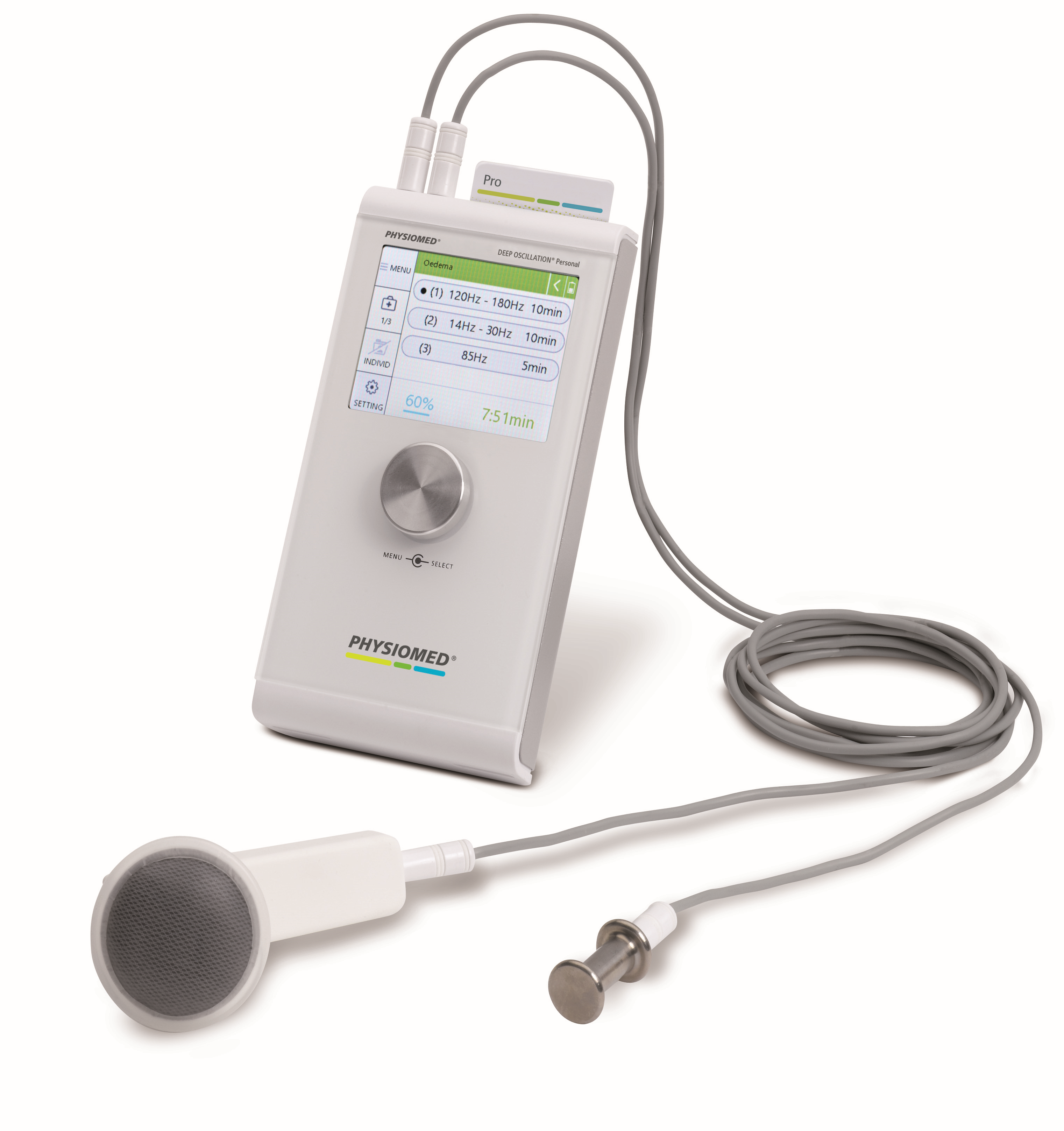
DEEP OSCILLATION® Personal - HOME Recover faster after trauma, training, overuse injuries, operations and neurological indications. DEEP OSCILLATION® Personal was designed for individual, mobile use. Its battery operation and handy size ensure flexible readiness for use both on the road and at home. The comprehensive list of indications with helpful information and graphics additionally facilitates use. The DEEP OSCILLATION® Personal can also be used to read and call up programme sequences that were previously written on the DEEP OSCILLATION® therapy card with the DEEP OSCILLATION® Evident. TEST NOW FOR 14 DAYS! The waiting time for a test device is currently about 2 months. We will be happy to advise you! General features: Intuitive user guidance with the PHYSIOMED one-button operation Colour screen Comprehensive overview of all therapy parameters Maximum quick access to the therapy via the indication index Extensive indication list with notes on therapy, dosage suggestions and illustrations Battery operation with powerful lithium-ion battery Highlight features: Indication list PHYSIOMED single-button operation Generous colour display Mode of action: In contrast to externally applied, mechanical forms of therapy (e.g., vibration), the therapy effect of DEEP OSCILLATION® occurs in the tissue itself and works over the entire depth of the tissue. DEEP OSCILLATION® is therefore particularly gentle and becomes an unsurpassed treatment alternative for fresh trauma, post-operatively, for acute pain and around open wounds. Reading tip: Use of matrix therapy for muscle injuries, Sportärztezeitung 02/2018. Therapy information: Deep oscillation (DEEP OSCILLATION®) is a unique, patented therapy method. By using electrostatic attraction and friction, impulses set the treated tissue into pleasant oscillations with a biological deep effect. In contrast to other forms of therapy, these oscillations have an extremely gentle and deep effect on all tissue components (skin, conductive tissue, subcutaneous fatty tissue, muscles, blood and lymph vessels). The following physiological effects of therapy with DEEP OSCILLATION® have been clinically documented: Pain reduction Anti-inflammatory effect Edema resorption Promotion of wound healing Antifibrotic effect Trophic improvement Skin redness reduction Detoxification Improvement of tissue quality For therapy, the patient holds a titanium contact element loosely between the fingers. Under the therapist's gloves or the hand applicator, which is moved in a circular motion over the tissue, the pleasant therapy effect of deep oscillation is created. DEEP OSCILLATION® is particularly suitable for the following applications due to its non-invasive, non-traumatic and highly effective approach: Pre- and postoperative therapy Lymphoedema Mechanical trauma and overuse injuries Secondary wound healing Burns Chronic pain conditions Neurorehabilitation Scope of delivery: DEEP OSCILLATION® Personal Instructions for use Hand applicator handle Charger Oscillator head Ø 5 cm PHYSIOPADS adhesive electrode for DEEP OSCILLATION® (set of 4) Powder Special gloves size M, 100 pieces Therapy card Home Titanium contact element Transport bag Connecting cable DEEP OSCILLATION® Connection cable grey for adhesive electrodes Please observe the following cleaning instructions: Make sure to switch off the unit before cleaning! Clean the unit with a surface disinfectant, e.g. 70% medical isopropanol or Dismozon® plus. Make sure that the cleaning agent does not contain benzene, ethanol, alcohol (except isopropanol), organic substances or dilutions. Clean the unit with a soft sponge cloth. Empty and clean the water separator, if present. Make sure that no liquid enters the unit. Please remove the water separator container for transport to avoid damage to the packaging. Please clean the unit before sending it for maintenance, even if it is not heavily contaminated. This way we can ensure the safety of our colleagues.Dieser Artikel wird nicht verkauft in folgende Länder: UK This item is not sold in the following countries: UK

DEEP OSCILLATION® Membrane Set (10 pieces) This set contains 10 replacement diaphragms for your DEEP OSCILLATION®. They are simply attached to the oscillator head by clamping them between the oscillator plate and the clamping ring. A diaphragm consists of a special conductive foam die-cut, a conductive adhesive element, and the diaphragm. They are available with diameters of 5 cm and 9.5 cm. Product details: Replacement membrane for your DEEP OSCILLATION® Scope of delivery: 10 membranes (Ø 5 cm or 9.5 cm)
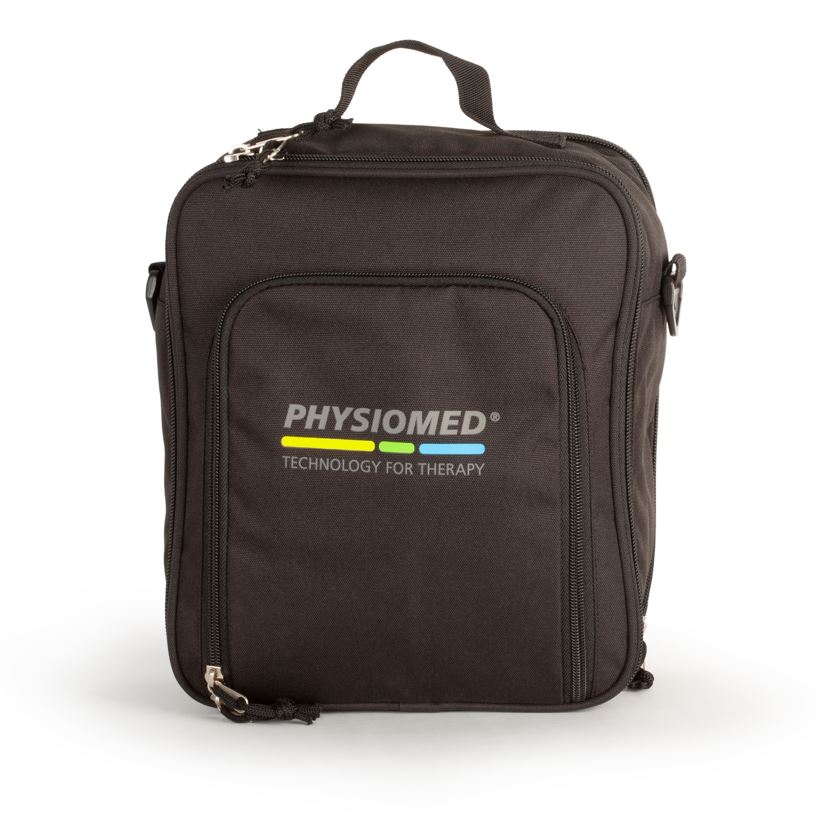
DEEP OSCILLATION® Transport Bag This transport bag is perfect for keeping your DEEP OSCILLATION® staff neat and safe. If your bag is broken, this product is the right choice for you. The interior is padded with foam to always protect all contents optimally. Various interior compartments make it easy to store your device and accessories neatly. The side pockets offer additional storage space. The carrying strap ensures comfortable and easy transport. Product details: Material: durable, high-quality polyester Incl. foam inlay, carrying strap and side pockets Dimensions approx. 30 x 25 x 16 cm Scope of delivery: 1 transport bag (without contents)
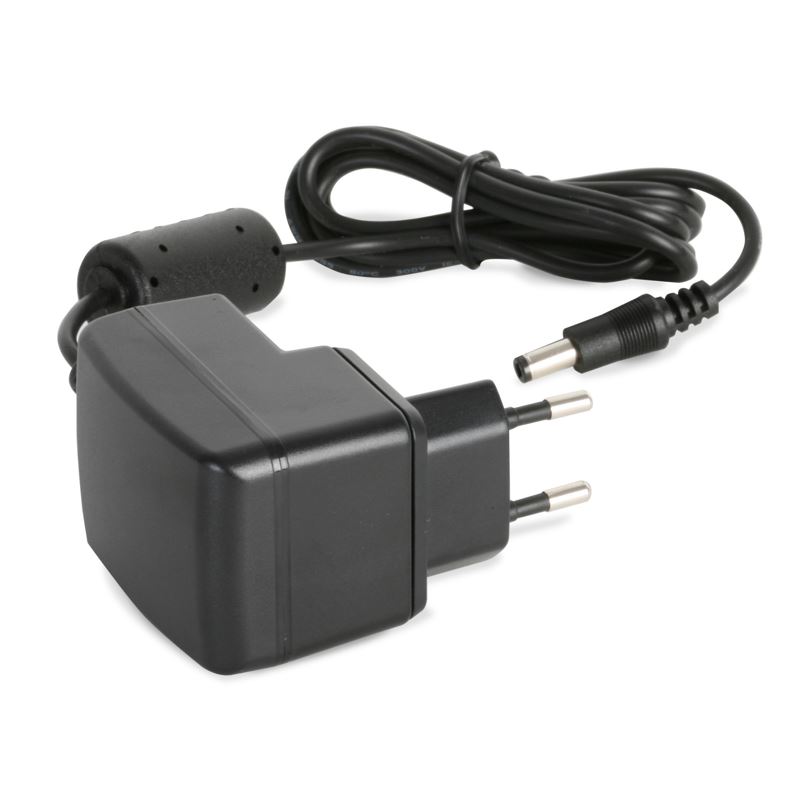
DEEP OSCILLATION® Personal charger With this charger you can charge the battery of your DEEP OSCILLATION® Personal. This item is a replacement unit. When you purchase a DEEP OSCILLATION® Personal Basic or Pro, a charger is included as standard. Product details: Compatible with DEEP OSCILLATION® Personal Basic and DEEP OSCILLATION® Personal Pro. Power supply unit with Euro plug (compatible with most sockets in EU countries) Scope of delivery: 1 charger
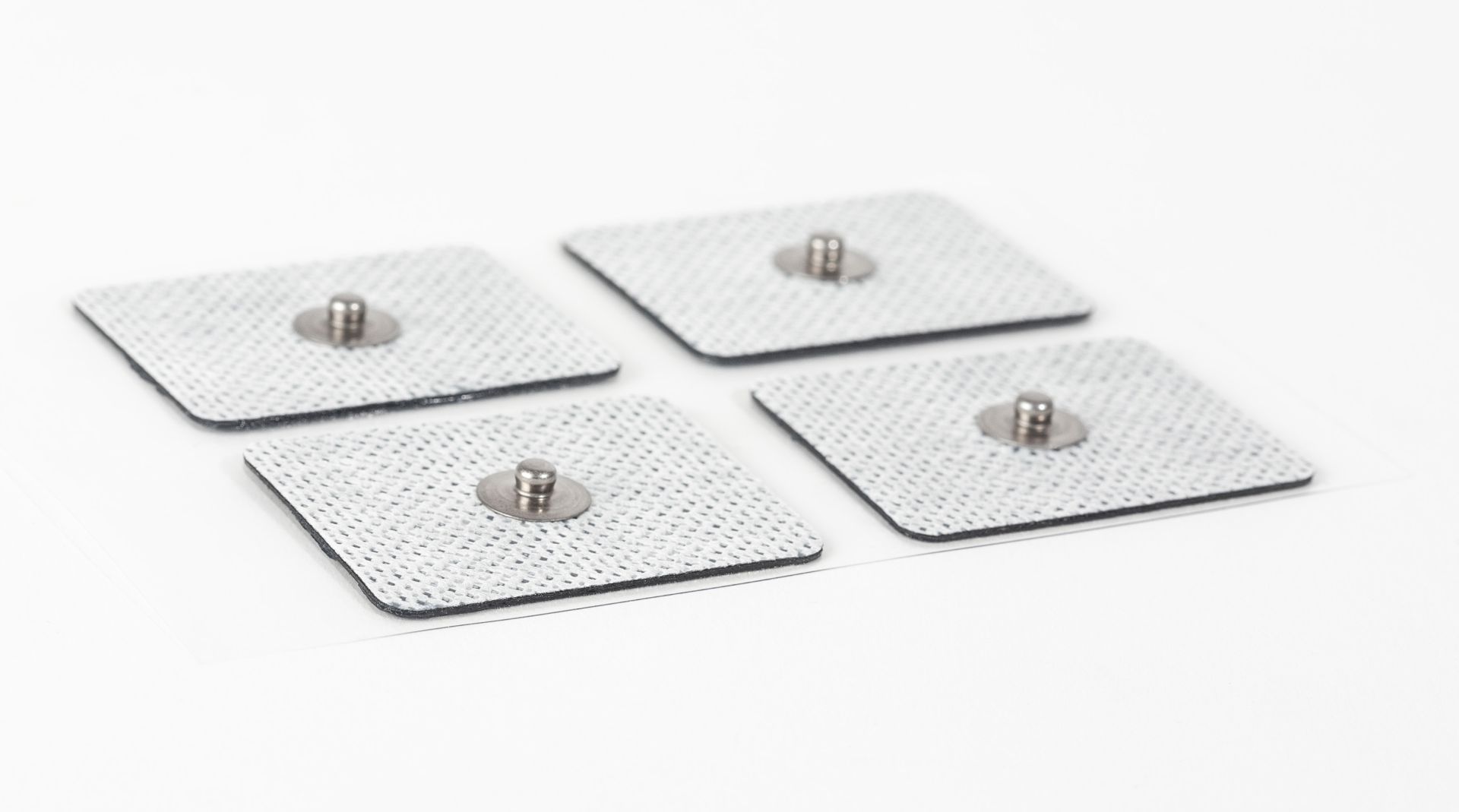
DEEP OSCILLATION® Reusable sticky electrodes (4 pieces) These electrodes for use with deep oscillation are singel-use adhesive electrodes with extremely good conductivity. They are connected to the device by means of connecting cables for sticky electrodes. Product details: Compatible with DEEP OSCILLATION®. Round, Ø 3.5 cm Scope of delivery: 4 reusable sticky electrodes
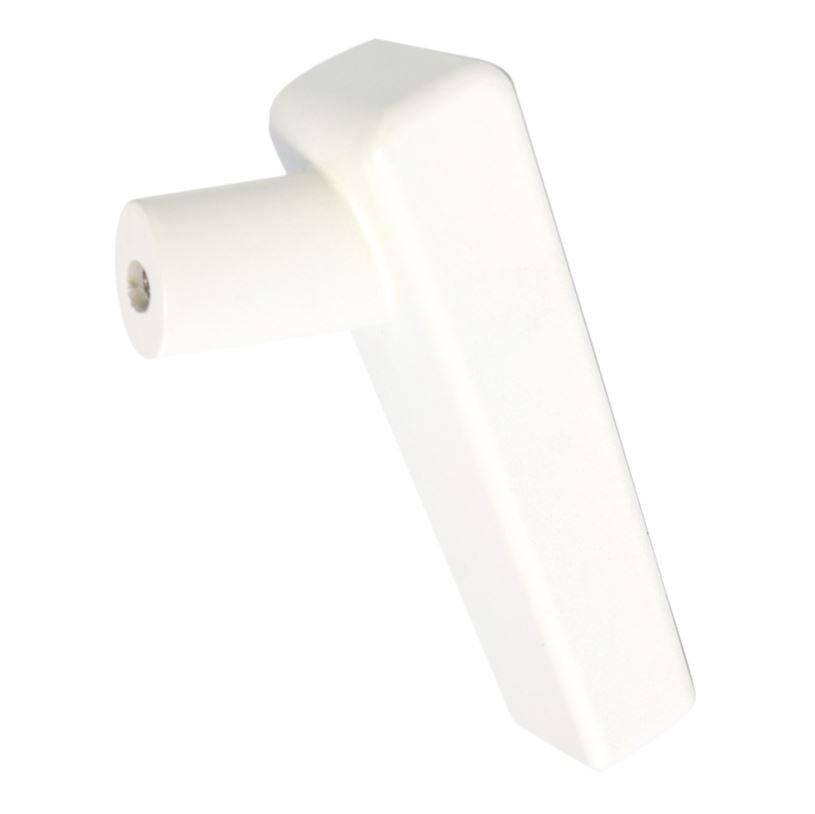
DEEP OSCILLATION® Hand Applicator Grip This hand applicator grip is a spare part for your DEEP OSCILLATION®. The oscillator heads are attached to it. The handle contains a plug-in connection for the spiral cable that connects the hand applicator to the device. Product details: Compatible with DEEP OSCILLATION® Suitable for oscillator heads with diameters of 9.5 cm and 5 cm Scope of delivery: 1 hand applicator grip
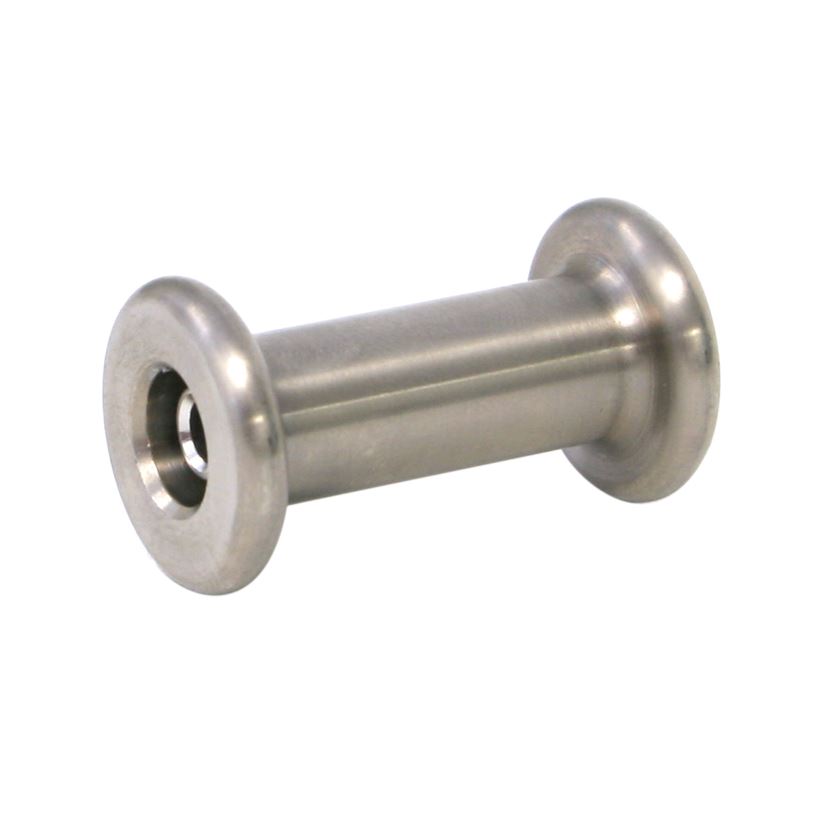
DEEP OSCILLATION® Titanium contact element This article consists of two titanium contact elements for your DEEP OSCILLATION®. The titanium contact element is held loosely between the fingers by the patient during treatment with DEEP OSCILLATION®. This creates the pleasant effect of deep oscillation when the therapist treats the body with the oscillator head or his hands. The contact element is plugged into the DEEP OSCILLATION® connection cable, which in turn is connected to the device via the patient cable. Product details: Compatible with DEEP OSCILLATION®. Material: biocompatible titanium in implant quality Scope of delivery: 1 titanium contact element
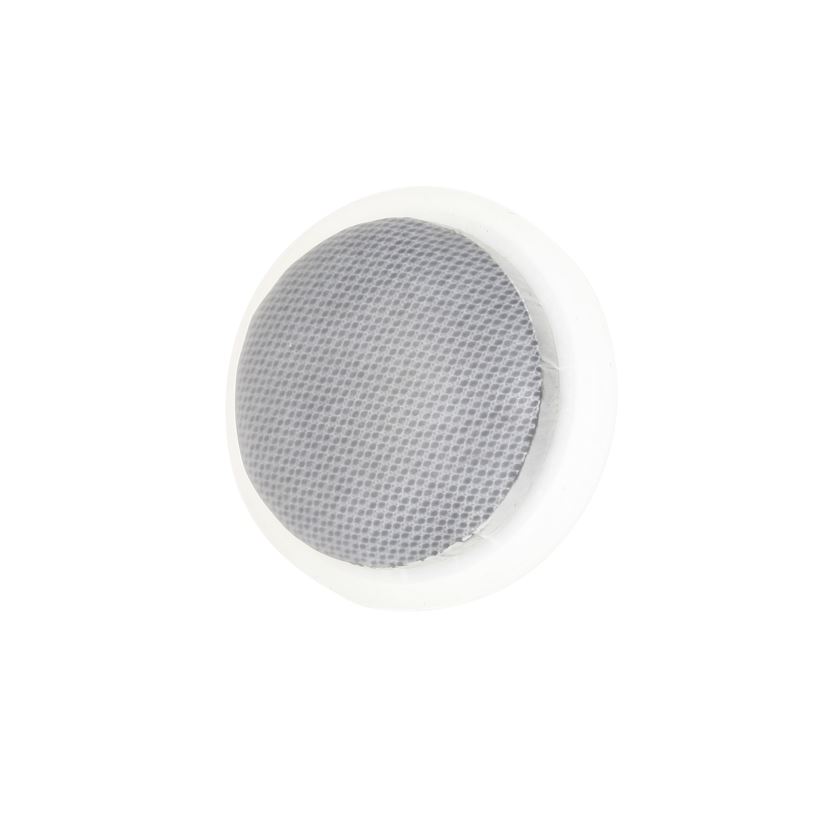
DEEP OSCILLATION® Oscillator Head This oscillator head is a spare part for your DEEP OSCILLATION®. It is attached to the hand applicator handle. This replacement oscillator head already has a membrane attached. Product details: Compatible with DEEP OSCILLATION® Scope of delivery: 1 oscillator head (Ø 5 cm or 9.5 cm) incl. 1 membrane

DEEP OSCILLATION® Connection Cable for Sticky Electrodes This connection cable provides a secure connection between the patient cable and the reusable adhesive electrodes. The connection to the unit is made via the patient cable. Connection: Unit - patient cable - connecting cable for sticky electrodes - sticky electrodes. The connection is made very simply by plug-in connection. Product details: Compatible with DEEP OSCILLATION®. Scope of delivery: 1 connection cable for sticky electrodes
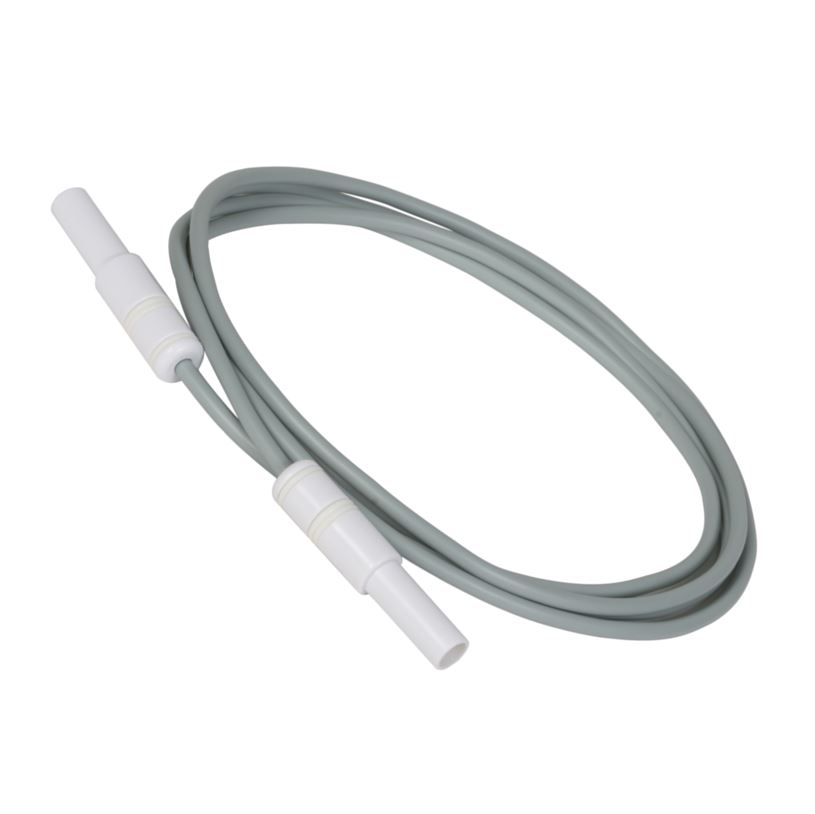
DEEP OSCILLATION® connecting cable The connecting cable "DEEP OSCILLATION®" connects the patient cable with the titanium contact element or with the hand applicator handle. Thus, a connection of the last two mentioned parts and the DEEP OSCILLATION® device is established. Possible connections: Unit - patient cable - connecting cable "DEEP OSCILLATION®" - titanium contact element Unit - Patient cable - Connecting cable "DEEP OSCILLATION®" - Hand applicator handle The connection to the patient cable, to the titanium contact element or to the hand applicator handle is made very simply by plug connection. Product details: Compatible with DEEP OSCILLATION® Scope of delivery: 1 connection cable
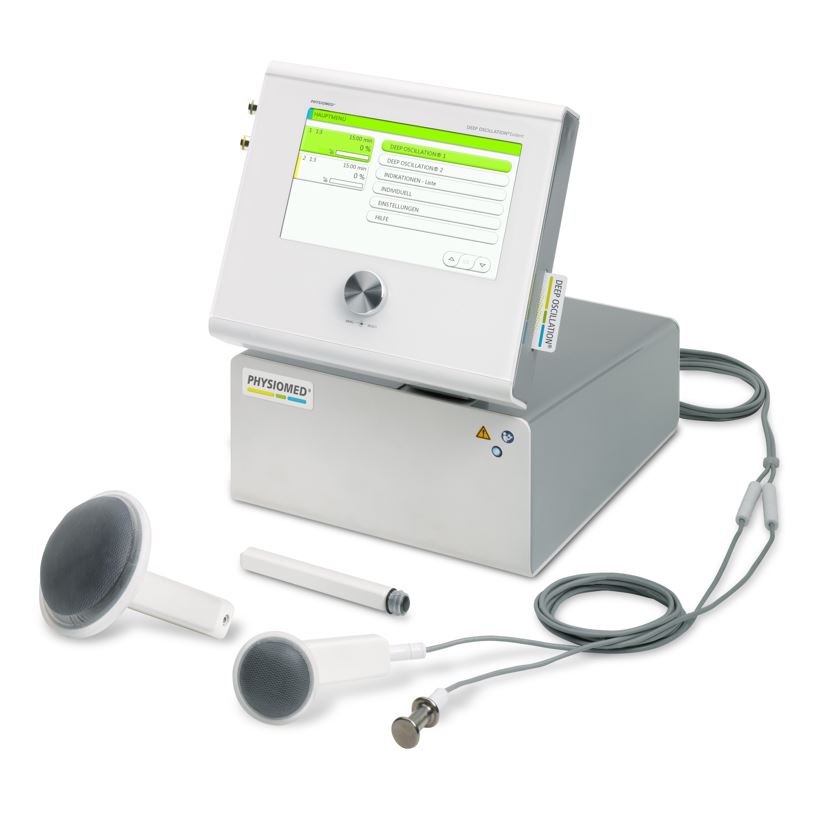
DEEP OSCILLATION® Evident Electrotherapy at the highest level With the patented procedure of deep oscillation, PHYSIOMED® has created a new milestone in electrotherapy. DEEP OSCILLATION® uses electrostatic attraction and friction to set the treated tissue into pleasant oscillations. This is said to accelerate performance, regeneration, and self-healing. DEEP OSCILLATION® also has a convinced circle of users in the beauty sector. Depending on the indication, pre-programmed treatments from the application areas of sports, medicine and beauty can be played. Performance and regeneration improvement Post-trauma Post-op and scar optimisation Pain and arthrosis therapy Lymphatic problems AESTHETICS software programme Safe, pleasant, and highly effective aesthetic treatments with anti-ageing effect and against cellulite. Faster healing after plastic surgery, cosmetic laser treatments and other invasive methods of aesthetic medicine. ORTHOSPORTS software programme Faster regeneration after training, trauma, overuse injuries and operations - for sore muscles, strains, inflammations, swellings, wounds. CLINICS software programme Faster regeneration after operations, trauma, and neurological indications - for pain, oedema, wound healing. Reading tip: Use of matrix therapy for muscle injuries, Sportärztezeitung 02/2018. Product details Deep oscillation in the frequency range of 5 - 250 Hz Treatment using hand applicators or the patient's own hands Operation with powerful lithium-ion battery Scope of delivery DEEP OSCILLATION® Evident Software package AESTHETICS or ORTHOSPORTS or CLINICS Instruction manual Device trolley Hand applicator handle Mains cable Oscillator head Ø 5 cm Oscillator head Ø 9.5 cm Patient cable PHYSIOPADS adhesive electrode for DEEP OSCILLATION® (set of 4) Powder, 100 g Special gloves size M, 100 pieces, powdered Therapy card DEEP OSCILLATION® Titanium contact element Connecting cable DEEP OSCILLATION® Connection cable grey for adhesive electrodes Please observe the following cleaning instructions: Make sure to switch off the device before cleaning! Clean the unit with a surface disinfectant, e.g., 70 % medical isopropanol or Dismozon® plus. Make sure that the cleaning agent does not contain benzene, ethanol, alcohol (except isopropanol), organic substances or dilutions. Clean the unit with a soft sponge cloth. Empty and clean the water separator, if present. Make sure that no liquid enters the unit. Please remove the water separator container for transport to avoid damage to the packaging. Please clean the unit before sending it for maintenance, even if it is not heavily contaminated. This way we can ensure the safety of our colleagues. Note:This product is a class II A medical device.Dieser Artikel wird nicht verkauft in folgende Länder: UK This item is not sold in the following countries: UK
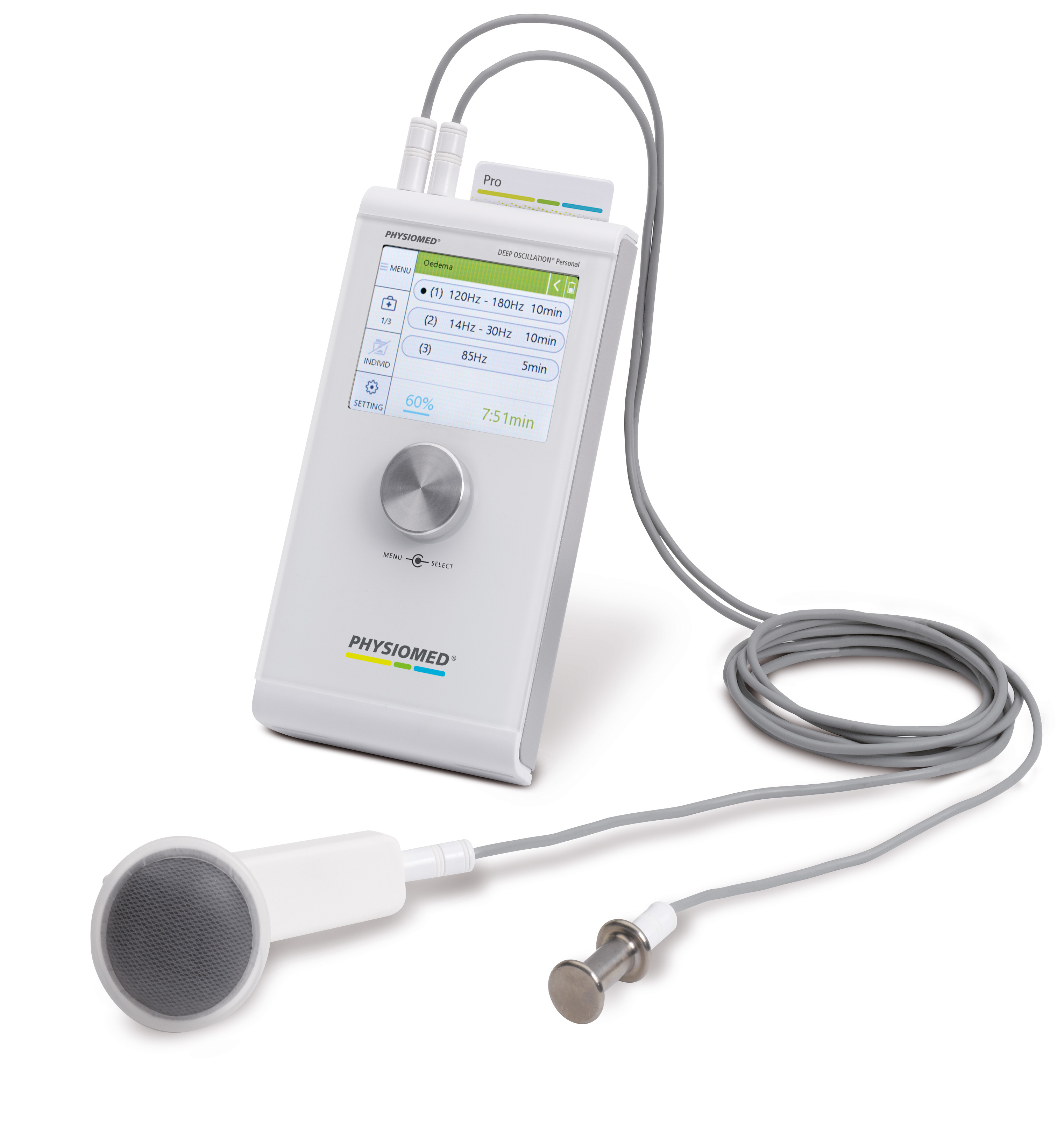
DEEP OSCILLATION® Personal - Pro Regenerate faster after trauma, training, overuse injuries, operations, and neurological indications. DEEP OSCILLATION® Personal was designed for individual, mobile use. Its battery operation and handy size ensure flexible readiness for use both on the road and at home. The comprehensive list of indications with helpful information and graphics additionally facilitates use. The DEEP OSCILLATION® Personal can also be used to read and call up programme sequences that were previously written on the DEEP OSCILLATION® therapy card with the DEEP OSCILLATION® Evident. TEST NOW FOR 14 DAYS! The waiting time for a test device is currently about 2 months. We will be happy to advise you! General features: Intuitive user guidance with the PHYSIOMED one-button operation Colour screen Comprehensive overview of all therapy parameters Maximum quick access to the therapy via the indication index Extensive indication list with notes on therapy, dosage suggestions and illustrations Battery operation with powerful lithium-ion battery Highlight features: Indication list PHYSIOMED single-button operation Generous colour display Mode of action: In contrast to externally applied, mechanical forms of therapy (e.g., vibration), the therapy effect of DEEP OSCILLATION® occurs in the tissue itself and works over the entire depth of the tissue. DEEP OSCILLATION® is therefore particularly gentle and becomes an unsurpassed treatment alternative for fresh trauma, post-operatively, for acute pain and around open wounds Reading tip: Use of matrix therapy for muscle injuries, sportärztezeitung 02/2018. Therapy information: Deep oscillation (DEEP OSCILLATION®) is a unique, patented therapy method. By using electrostatic attraction and friction, impulses set the treated tissue into pleasant oscillations with a biological deep effect. In contrast to other forms of therapy, these oscillations have an extremely gentle and deep effect on all tissue components (skin, conductive tissue, subcutaneous fatty tissue, muscles, blood and lymph vessels). The following physiological effects of therapy with DEEP OSCILLATION® have been clinically documented: Pain reduction Anti-inflammatory effect Edema resorption Promotion of wound healing Antifibrotic effect Trophic improvement Skin redness reduction Detoxification Improvement of tissue quality For therapy, the patient holds a titanium contact element loosely between the fingers. Under the therapist's gloves or the hand applicator, which is moved in a circular motion over the tissue, the pleasant therapy effect of deep oscillation is created. DEEP OSCILLATION® is particularly suitable for the following applications due to its non-invasive, non-traumatic and highly effective approach: Pre- and postoperative therapy Lymphoedema Mechanical trauma and overuse injuries Secondary wound healing Burns Chronic pain conditions Neurorehabilitation Scope of delivery: DEEP OSCILLATION® Personal Instructions for use Hand applicator set, consisting of 1x hand applicator handle, 2x oscillator head Ø 5 cm, 2x oscillator head Ø 9.5 cm, 1x DEEP OSCILLATION® connection cable Charger PHYSIOPADS adhesive electrode for DEEP OSCILLATION® (set of 4) Powder Special gloves size M, 100 pieces Therapy card Pro Titanium contact element Transport bag Connecting cable DEEP OSCILLATION® Connection cable grey for adhesive electrodes Please observe the following cleaning instructions: Make sure to switch off the unit before cleaning! Clean the unit with a surface disinfectant, e.g., 70% medical isopropanol or Dismozon® plus. Make sure that the cleaning agent does not contain benzene, ethanol, alcohol (except isopropanol), organic substances or dilutions. Clean the unit with a soft sponge cloth. Empty and clean the water separator, if present. Make sure that no liquid enters the unit. Please remove the water separator container for transport to avoid damage to the packaging. Please clean the unit before sending it for maintenance, even if it is not heavily contaminated. This way we can ensure the safety of our colleagues. Note:This product is a class II A medical device.Dieser Artikel wird nicht verkauft in folgende Länder: UK This item is not sold in the following countries: UK

DEEP OSCILLATION® Personal - Basic Recover faster after trauma, training, overuse injuries, operations and neurological indications. DEEP OSCILLATION® Personal was designed for individual, mobile use. Its battery operation and handy size ensure flexible readiness for use both on the road and at home. The comprehensive list of indications with helpful information and graphics additionally facilitates use. The DEEP OSCILLATION® Personal can also be used to read and call up programme sequences that were previously written on the DEEP OSCILLATION® therapy card with the DEEP OSCILLATION® Evident. TEST NOW FOR 14 DAYS! The waiting time for a test device is currently about 2 months. We will be happy to advise you! General features: Intuitive user guidance with the PHYSIOMED one-button operation Colour screen Comprehensive overview of all therapy parameters Maximum quick access to the therapy via the indication index Extensive indication list with notes on therapy, dosage suggestions and illustrations Battery operation with powerful lithium-ion battery Highlight features: Indication list PHYSIOMED single-button operation Generous colour display Mode of action: In contrast to externally applied, mechanical forms of therapy (e.g., vibration), the therapy effect of DEEP OSCILLATION® occurs in the tissue itself and works over the entire depth of the tissue. DEEP OSCILLATION® is therefore particularly gentle and becomes an unsurpassed treatment alternative for fresh trauma, post-operatively, for acute pain and around open wounds. Reading tip: Use of matrix therapy for muscle injuries, Sportärztezeitung 02/2018. Therapy information: Deep oscillation (DEEP OSCILLATION®) is a unique, patented therapy method. By using electrostatic attraction and friction, impulses set the treated tissue into pleasant oscillations with a biological deep effect. In contrast to other forms of therapy, these oscillations have an extremely gentle and deep effect on all tissue components (skin, conductive tissue, subcutaneous fatty tissue, muscles, blood and lymph vessels). The following physiological effects of therapy with DEEP OSCILLATION® have been clinically documented: Pain reduction Anti-inflammatory effect Edema resorption Promotion of wound healing Antifibrotic effect Trophic improvement Skin redness reduction Detoxification Improvement of tissue quality For therapy, the patient holds a titanium contact element loosely between the fingers. Under the therapist's gloves or the hand applicator, which is moved in a circular motion over the tissue, the pleasant therapy effect of deep oscillation is created. DEEP OSCILLATION® is particularly suitable for the following applications due to its non-invasive, non-traumatic and highly effective approach: Pre- and postoperative therapy Lymphoedema Mechanical trauma and overuse injuries Secondary wound healing Burns Chronic pain conditions Neurorehabilitation Scope of delivery: DEEP OSCILLATION® Personal Instructions for use Hand applicator handle Charger Oscillator head Ø 5 cm PHYSIOPADS adhesive electrode for DEEP OSCILLATION® (set of 4) Powder Special gloves size M, 100 pieces Therapy card Basic Titanium contact element Transport bag Connecting cable DEEP OSCILLATION® Connection cable grey for adhesive electrodes Please observe the following cleaning instructions: Make sure to switch off the unit before cleaning! Clean the unit with a surface disinfectant, e.g. 70% medical isopropanol or Dismozon® plus. Make sure that the cleaning agent does not contain benzene, ethanol, alcohol (except isopropanol), organic substances or dilutions. Clean the unit with a soft sponge cloth. Empty and clean the water separator, if present. Make sure that no liquid enters the unit. Please remove the water separator container for transport to avoid damage to the packaging. Please clean the unit before sending it for maintenance, even if it is not heavily contaminated. This way we can ensure the safety of our colleagues. Note:This product is a class II A medical device.Dieser Artikel wird nicht verkauft in folgende Länder: UK This item is not sold in the following countries: UK
What is deep oscillation?
Deep oscillation, known as DEEP OSCILLATION®, is based on a unique and patented therapy method. It is based on the creation of a pulsating electrostatic field during treatment, which is generated between the therapist's hands or the applicator and the patient's tissue. Through the skillful use of electrostatic attraction and release (friction), impulses are generated that cause the tissue to vibrate and thus achieve a biological depth effect of up to 8 cm. The treated structures are "shaken" and loosened by this electrostatic attraction. This results in an extremely effective activation of the flow of extracellular fluids through the deep resonance vibration - deep oscillation. The technique intensifies cell supply and removal, stimulates the metabolism and increases the flow balance between cells as well as absorption into the lymphatic and venous system. The supply of oxygen and nutrients via the arterial system is also improved. Thanks to its gentle nature, deep oscillation is successfully used in various medical and therapeutic areas.
Pain reduction through a two-level approach
Deep oscillation uses a dual approach to support the body in reducing pain by intervening on both a biochemical and mechanical level. This approach aims to promote the exchange of fluids between the vessels and the cells and to break the pain cycle.
Level 1: Biochemical support through fluid exchange and thixotropy
Deep oscillation relies on the mechanism of thixotropy to liquefy fluids in the body. Especially in the lymphatic system, which is responsible for the removal of waste products and other substances, the liquefaction of the tissue makes it much easier to cope with overloading, injuries and surgical interventions. Liquefaction (of the tissue) removes waste products and neuroactive substances that can sensitize the area of pain. In addition, the pH value is rebalanced, which leads to an improvement in well-being and a reduction in pain. This support plays a decisive role in general lymphatic problems such as after overloading, injury and surgery, but also in lymphoedema and lipoedema.
Level 2: Activation of mechanoreceptors
Deep oscillation also aims to activate mechanoreceptors in the body. This is closely linked to the gate control theory, which states that the stimulation of mechanoreceptors takes precedence over the perception of pain in evolutionary terms. By activating these mechanoreceptors, the transmission of pain at spinal cord level is reduced, which leads to a reduction in pain. This approach is also referred to as "counter irritation", as the activation of the mechanoreceptors virtually overrides and inhibits the pain.
The combination of both levels allows deep oscillation to provide a comprehensive approach to pain reduction that works on both a biochemical and mechanical level. This helps to break the pain cycle and help the body to achieve more effective pain control in order to be able to perform all movements again.
Advantages of deep oscillation
Compared to other electrotherapy methods, deep oscillation offers numerous advantages. Thanks to its gentle mode of action, it gently develops its effects throughout the entire depth of the tissue - from the skin and subcutaneous fatty tissue to muscles, arteries, veins and lymph vessels. The deep effect is achieved with minimal mechanical impact, which opens up innovative treatment options for therapists.
The advantages at a glance:
- Gentle and well tolerated, enables early use in cases of severe pain and hematomas, as well as injuries and operations
- Accelerated healing and rapid treatment success without medication Improved quality of life thanks to freedom from pain and movement
- Outpatient treatment with a high chance of success
- Restoration of performance and reduced recovery time
- Treatment options in the area of open wounds
- The therapy can be learned quickly
- Proven for 30 years and used worldwide
- Scientifically proven through studies
Using deep oscillation: how it works
The application of deep oscillation is similar in principle to a massage. The therapist uses either special vinyl gloves or a hand applicator. Gentle circular movements over the tissue create the pleasant deep oscillation. During the treatment, the patient holds a titanium contact element in their hand to generate the deep vibrations by means of a local electrostatic field. This creates the beneficial therapeutic effect of deep oscillation.
There are basically three different application techniques:
- Therapy with special gloves,
- therapy with a hand applicator or
- application with applied foil.
To facilitate use, a comprehensive indication list with helpful information and graphics is included with the purchase of the devices.
When deep oscillation makes sense
Deep oscillation as an electromechanical therapy method is increasingly being used in various areas of rehabilitation around the world. In general, deep oscillation is always an option when the metabolism needs to be activated or intensified.
Areas of application
Orthopaedics / Traumatology / Surgery
- Pain syndromes
- Treatment of trauma and neurological damage
- Pre- and post-operative therapy
Deep oscillation can be used immediately after operations and prevents local edema and adhesions. It promotes mobility and can reduce pain as well as promote the healing of scars
Wound treatments
- Ulcers, amputations and burns
- Treatment in the wound area over film or in the immediate vicinity of the wound edges
The treatment visibly improves the supply and disposal situation and supports dynamic wound healing.
Beauty and aesthetics
- Cellulite treatments
- Anti-ageing treatments for the face, neck and décolleté
- Aftercare for aesthetic procedures and cosmetic laser treatments
Sport and exercise
- Preparation for performance
- Post-training care and performance stabilization
- Treatment of trauma and overuse injuries
Postpartum (puerperium)
- Postpartum breast pain and tension (breast engorgement)
- Post-operative therapy for caesarean section scars
- Scar treatment such as episiotomy
Respiratory diseases (cystic fibrosis, COPD)
- Can promote lasting relaxation of the respiratory muscles
Neurology
- Promotion and maintenance of sensory abilities
- Pain reduction
- Improvement of initiation
Contraindications to deep oscillation
The use of deep oscillation is extremely safe, but treatment should be avoided in certain situations.
This applies to:
- Active tuberculosis
- Untreated thromboses and vascular diseases
- Erysipelas (erysipelas)
- Untreated malignant haematological diseases
- Cardiac complaints and diseases
- Patients with pacemakers and other electronic implants
- Pregnancy
- Sensitivity to electric fields
The contraindications mentioned apply to therapy with special gloves for both the patient and the therapist.
After the first treatment: What to look out for
It is important to note that patients may experience the following symptoms after the first deep oscillation treatment:
- Acute sensation of pain in the treated area (usually disappears a few hours after the treatment)
- Increased urge to urinate and possible changes in the urine in terms of smell and color
- Increased sensitivity of the treated skin area
- Slight tiredness and feeling of exhaustion
- Possible reduction in blood pressure
- Slightly increased body temperature
To minimize possible reactions to the treatment, we recommend that patients drink plenty of fluids before and after deep oscillation. This can help to avoid possible discomfort and support the positive effect of the treatment in the best possible way.
Preparing for treatment: tips for patients
Before a deep oscillation treatment, patients can take some simple preparatory steps to get the best possible results from their therapy. Beforehand, we recommend that patients wear comfortable clothing - preferably loose and breathable - that allows the therapists easy access to the areas to be treated. It is also advisable to drink plenty of fluids before the treatment. Good hydration not only supports the metabolism, but also blood circulation during the treatment. Immediately before the deep oscillation treatment, we recommend removing any jewelry or accessories to ensure that the therapy runs smoothly and comfortably.
Scientific studies on the effectiveness of deep oscillation
Study 1
This study investigated the effects of different pain treatment approaches in patients with paravertebral and peripheral radicular pain. The participants were divided into three groups: One received medication only, one received a combination of medication and physical analgesia, and the third group received physical modalities only, including Deep Oscillation (DO).
The study emphasizes the effectiveness of physical analgesia with deep oscillation, which has a slower onset but provides lasting results. The combination of drug and physical therapy was particularly successful, as it showed synergistic effects. The study underlines the importance of physical analgesia, especially deep oscillation, for long-lasting pain relief.
Study 2
The study investigated the effect of the combined application of deep oscillation and kinesiotherapy on the recovery of patients after knee replacement surgery. Fifty knee replacement patients were divided into two groups: an experimental group (EG) and a control group (CG).
The results concluded that deep oscillation is an effective method to reduce inflammation, edema and pain and increase range of motion in early rehabilitation after knee replacement. In addition, improved mobility was observed in the early rehabilitation stage after knee replacement. Combined use with appropriate exercises leads to better results in terms of speed and stage of functional recovery.
Study 3
The third study investigated the use of deep oscillation as a supplementary treatment method for various sports injuries in addition to standard therapy. 49 sports injuries in 14 people were treated, with the subjective assessment of symptoms on the VAS scale improving significantly from 8.7 (baseline) to 2.1 after treatment. The objective assessment by the treating physician showed good or very good results in 90% of cases.
Deep oscillation proved to be a cost-effective and easy-to-use adjuvant treatment option for sports injuries. The positive effects already observed in other indications such as edema reduction, pain relief and promotion of movement were also confirmed in acute sports injuries. The gentle mode of action of deep oscillation allows its use in the acute phase without contraindications and is well accepted by patients.
